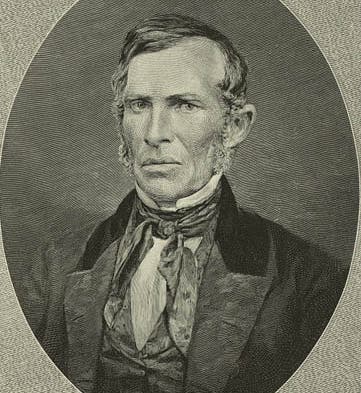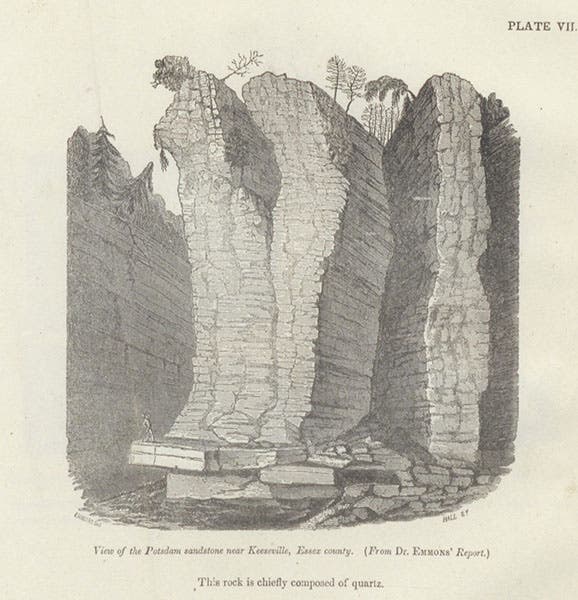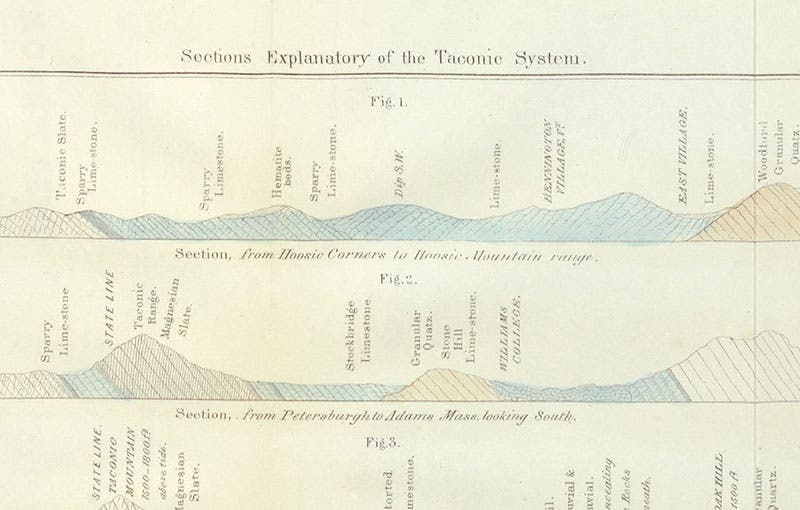Scientist of the Day - Ebenezer Emmons
Ebenezer Emmons, an American geologist, was born May 16, 1799, in Middlefield, Mass. He studied to be a physician, and would later have a medical practice, but he encountered the geologist Amos Eaton at Williams College and became smitten with rocks and strata. He followed Eaton to the new Rensselaer Institute, where he studied geology. He accepted teaching positions at both Williams and Albany Medical College, and managed to hold both jobs for many years – a good trick, I must say.
In 1836, he joined the Geological Survey of New York State, which was planning a set of official volumes on the geology, agriculture, and natural history of New York. There were four geologists at work, and Emmons was assigned district 2, which encompassed the upper northeast corner of the state, including Clinton, Jefferson, and Essex counties, and the Adirondack Mountains (which Emmons named, by the way). Much of that area is bedrock gneiss, overlain by ancient stratified rock. There are places where a formation known as the Potsdam sandstone sits on the gneiss, and it was suspected that the Potsdam sandstone was the bottom of the geological column and the oldest sedimentary strata in New York. But Emmons found evidence in the convoluted rocks that there were strata older than the Potsdam, containing very primitive fossils, and he called this older system of rocks the Taconic system. In England, Roderick Murchison had discovered the Silurian System in Wales, arguing that it was the oldest stratigraphic sequence containing evidence of life. Adam Sedgwick had proposed a lower and older system, the Cambrian, but Murchison subsumed the Cambrian into his own Silurian system. Emmons, in the United Steates, argued that the Taconic system was the primordial strata, followed by Murchison's Silurian system.
In 1842, Emmons published volume 2 – his volume – in the Geology of New York series, where he made his case for the Taconic system. We have the complete Natural History of New York set in our collections, including the five-volume Geology of New York. In a chapter in his volume, Emmons presented his evidence for the Taconic system, and in plates at the end, he provided many geological sections that illustrated his system. We show some of those here. He also included several views in the text, one of Potsdam sandstone (second image), and another of the Adirondacks, including the tallest peak, Mount Marcy, which Emmons happened to be the first to climb (third image).
Jules Marcou, the French geologist who followed Louis Agassiz to the United States, and whom we profiled nearly a month ago, considered Emmons to be the supreme stratigrapher in America and the first anywhere to find evidence of original life forms in the rocks. He was all in favor of the Taconic system. But James Hall, Emmons’ boss on the New York survey, was not so sure a Taconic system could be defined, and neither were most other American geologists; they thought the Taconic formations were “post-Potsdam,” as they put it. They clung to older terms for the base system, the New York group, or the Hudson River group, with the Potsdam sandstone as its base, although we now know that Emmons was right and the Potsdam sandstone is an upper, not lower, Cambrian formation. The disagreement grew nasty, and Emmons was ostracized and forced to resign and move to North Carolina, where he headed up the Geological Survey in that state. He died there in 1864, during the Civil War, an unhappy Yankee in a land of secessionists. He never did witness the success of his Taconic system.
And neither did anyone else. If American geologists had supported Emmons, the Taconic system would have become the recognized base of the Paleozoic, since the Cambrian system was being rejected in England in the 1840s and 1850s. But eventually, it was too late, as the English re-accepted the Cambrian system, with a new system, the Ordovician, as a buffer between the Cambrian and the Silurian. And the Taconic system disappeared as a name, replaced by Cambrian, although the New York rock formations remained, as silent venerable witnesses to Emmons’ stratigraphic skill, and the bone-headedness of his opposition.
Emmons was buried in Raleigh, N.C., but at some point, his remains were moved north and a memorial stone commemorating Ebenezer and his wife was erected in his birth town of Middlefield, Mass. (sixth image).
William B. Ashworth, Jr., Consultant for the History of Science, Linda Hall Library and Associate Professor emeritus, Department of History, University of Missouri-Kansas City. Comments or corrections are welcome; please direct to ashworthw@umkc.edu.












